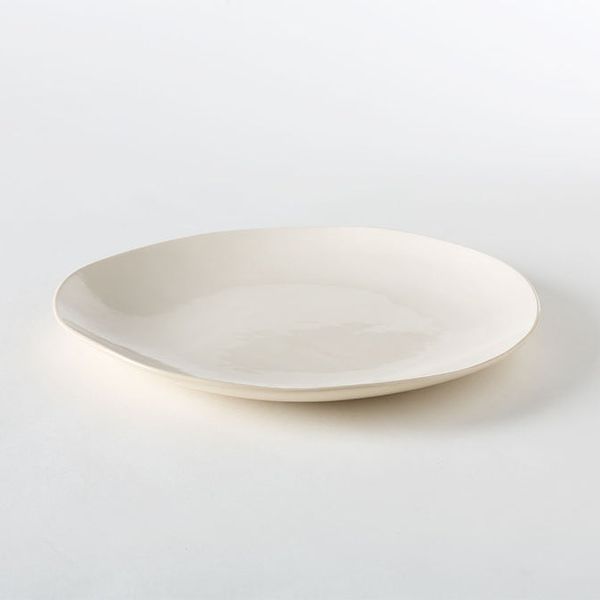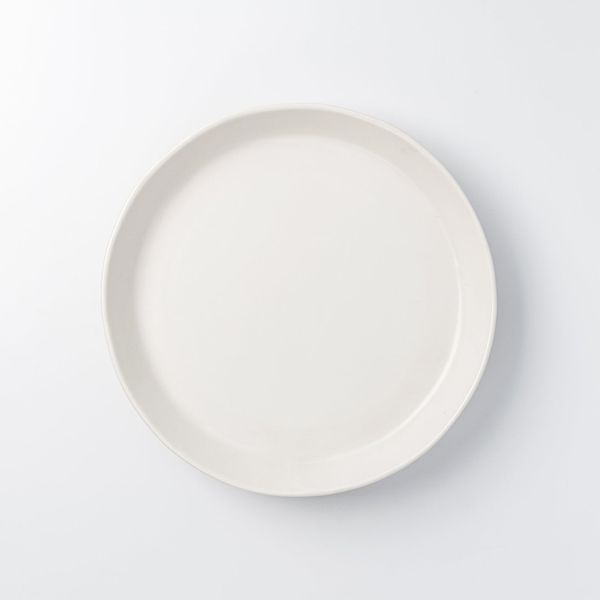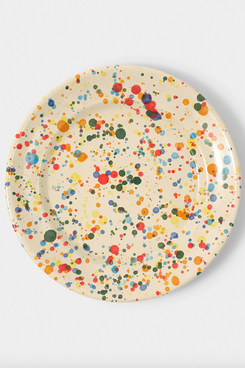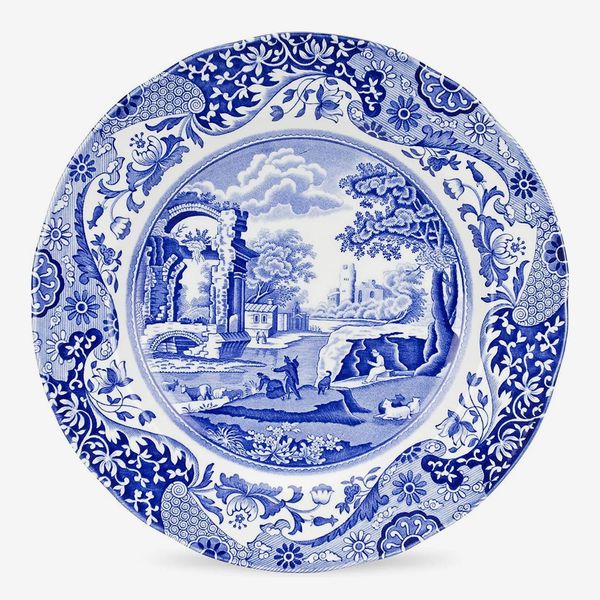
While there’s no singular quality that makes a great dinner plate, you know when you have a less-than specimen: It looks cheap, and it chips and scratches easily. Among those that are well made, what you choose to set your table with is really up to personal preference. Do you like a heavier material, like stoneware or ceramic, or something lighter, like porcelain? Do you want a matte finish or a shiny one? A larger surface area or something smaller? A prominent rim or lip? Are you willing to shell out more money for handmade pieces, or do you prefer a cheaper set you can put through the wringer (and dishwasher) without worry?
To make up this non-exhaustive but still-extensive list of options, I surveyed over 50 chefs and recipe developers, home cooks and avid hosts, designers and prop stylists, and Strategist staffers. From there, I narrowed down selections to be accessible (meaning you won’t find any vintage china you have to hunt down on eBay or enormously expensive pieces here). Then I sorted them into two main sections: white and off-white, colored and decorative. All of these have been used by their respective recommenders for everyday table setting, eating, and washing — in many cases, for a substantial number of years — so you know they’re to be trusted. And if you’re in the market for bowls, you can find my guide to those here too.
Update on October 18, 2024: Updated prices and checked stock for all products.
White and Cream Plates
These plates come recommended by both Los Angeles’s Botanica co-owner, Heather Sperling, and chef and food stylist Romilly Newman. Sperling likes the light sheen of the finish and that the pieces are thin yet sturdy. Each plate is under 11 inches in diameter. It’s a “large-enough-but-not-giant size,” she says. Newman says they’re imperfect in a way that feels natural and elegant, sophisticated enough for a multicourse seated dinner but approachable enough for a dinner for one.”
Fable’s stoneware dinner plates were mentioned by three people. Recipe developer and cookbook author Carissa Stanton uses them for regular meals as well as for dinner parties because guests can easily put three to five different foods together without worrying about overflow. “I also just love the way they look and feel,” she says. “They have a great weight to them.” Strategist writers Brenley Goertzen and Jeremy Rellosa are also fans; both point out that each plate, even among a set, is slightly unique. This gives them a “less mass-manufactured quality,” Rellosa says. Goertzen notes that the raised rim helps contain meat juices or more liquid-y dishes.
“Stoneware feels handmade and has a warm, natural look,” says restaurateur Brooks Reitz, adding that with these plates, “the gentle bone color is much more elegant than a ripping, bright white.” He calls them clean and utilitarian. “From afar they are perhaps unremarkable, but up close and in the hand, they are clearly beautifully made,” he says. The designer, John Julian, has other styles, too, like this one with a forest-green rim used by Olivia Pollock, senior brand director of Evite. “It’s classic and suitable for everyday meals with my littles but can also double for elevated dinner parties,” she says.
[Editor’s note: This plate is listed in pounds, so the price shown is an approximate conversion in U.S. dollars.]
When it comes to tableware from bigger-box stores, Crate & Barrel is the clear favorite. This style is the choice of recipe developer and writer Caroline Chambers, who ordered two sets for a dinner party a few years back but quickly adapted them as the everyday plates for her family of five. “They’re only about $7 each, and they look like really pretty ceramics,” she says. “Not a single chip, and I’ve used them exclusively as my plates for about two years.”
Fashion designer, culinary creator, and lifestyle expert Peter Som uses the Aspen Coupe Dinner Plate, which has a cleaner finish and more significantly sloped sides that he says frame food nicely and provide a substantial barrier between fork and floor, if he’s eating in a more casual setting, like in front of the TV. “They are crisp and white and lightweight but sturdy — the veritable little black dress of the dinner table that will make anything I put on it pop,” he says.
These have a more traditional design with a wide rim and are the plates that Strategist senior editor Hilary Reid received as a hand-me-down from one of her best friends about five years ago. “Not one has cracked, scratched, or really shown any significant sign of wear,” she says. “They are just simple, extremely reliable, boring but not too boring, and in a style that I don’t think I’ll ever get tired of. Plus they stack nicely.”
Although not as many people I talked to own Sur La Table plates, the Bistro line got enthusiastic shout-outs from two Strategist staffers: writer Lauren Ro and senior editor Jen Trolio. (Both own the full set.) Ro calls them lightweight, durable (she has owned hers since 2019, and none of the plates have chipped), and easy to stack, which she does on open shelving in her kitchen. “They’re great for everyday dining and look presentable for guests,” she says. Trolio has owned hers for even longer (that’s major points for being able to expand your set or replace pieces as needed). She says they’re a good weight and size and are easy to use and to clean. But she’s most drawn to their simplicity since she prefers to add color to her table via other accessories — and this also means she has never gotten tired of them at any point in the past 14 years.
Recipe developer and writer Rebecca Firkser uses these matte-finished Casafina plates. “I think many ‘organic-shaped’ dishes from commercial purveyors look purposefully inauthentic, so I like that these are evenly round,” she says. She prefers the look of the flatter shape, too, but notes there’s still enough of a lip to catch food and assures that they’re extremely durable. “I’ve had these for over four years with no noticeable nicks or scratches from flatware, and I’ve run them through the dishwasher countless times,” she says.
Sylvan Mishima Brackett, owner of Rintaro in San Francisco, got his first set of Apilco plates from Chez Panisse, where he used to work. When the restaurant collaborated with Heath Ceramics to create custom tableware, it gave away the formerly used Apilco pieces to the staff. “I’ve stuck with them ever since,” Brackett says. He calls them “simple and elegant,” noting that they don’t call attention to themselves, which allows the food to be the focus. They stack tightly in the cupboard, so he can fit a dozen (same as with the company’s salad plates and bowls, which he also has). “And after years of use, they still look exactly the same — not a single chip or crack or stain,” he says.
Recipe developer and cookbook author Claire Saffitz recently invested in a new set of dinnerware, doing a “huge amount of research” to find the pieces that checked her many boxes, she says: organic form, matte white for versatility, and between ten and 11 inches. She loves that they’re handmade and feel special. Still, they’re a great weight and durable. “I wasn’t certain about the prominent lip,” she says, “but now I really like how it frames the food and contains everything.” She does note that a matte finish means cutlery can leave marks, but those can be removed with special cleaning (and don’t bother her too much anyway).
“On balance, I try to buy inexpensive dishware because I constitutionally cannot treat them with delicacy and care,” says New Yorker food columnist Helen Rosner. At $4 a pop, these Ikea plates fit the bill, though their cheap price tag doesn’t affect how lasting they are. Rosner has owned them for 15 years, and they’re still in near-perfect condition. Otherwise, they also check her three dinner-plate nonnegotiables: They’re round, they’re white (because all food looks good on white, and they can be used just as easily for fancy dinner parties as everyday meals), and they have a decent rim. “Without a rim, you end up with this vast, flat emptiness, which is both aesthetically unwieldy in terms of plating and functionally annoying when it comes to using a knife,” she says.
Strategist writer Erin Schwartz says Muji’s plates are “the Platonic ideal of inexpensive but nice-looking.” (They own the lunch-plate size, which is only an inch smaller in diameter than the dinner plate and perfect for their needs.) They describe the color as a subtle off-white and note that the plates “don’t have that chunky, thick-walled feel you get from some cheap models where the glaze is absolutely shellacked on.” Both Schwartz and recipe developer and food stylist Sue Li, who owns the plates in a brighter white that isn’t currently available, say the dishes aren’t too delicate to throw in the dishwasher with Li adding that she doesn’t feel devastated if one happens to break, given the affordable price point.
For another affordable option, consider this set from Corelle, recommended by food stylist Rebecca Jurkevich, who likes that these are lightweight, can go in the dishwasher, and are unimposing so that the food can be the star. The best part? “I am so not fancy at home,” she says. “Anything beautiful that I’ve owned gets destroyed, so here we are. They are (nearly) unbreakable. Who doesn’t love that?”
Colorful and Decorative Plates
Emily Fiffer, the other co-owner of Botanica, has lugged big plates, small plates, and bowls back from Onora in Mexico City. “Owning a restaurant, I’m all too familiar with breakage, so I love the weight of these. They’re so sturdy!” she says. “Plus they’re beautiful.” She appreciates that they’re not crazy expensive, as some handmade ceramics can be, and says they “read casual or a bit elevated depending on the audience and situation.”
Falcon Enamelware’s plates are, as the name suggests, made of enamel. This means they’re super-durable — so much so that they were recommended by multiple experts as the very best outdoor dinner plates you can buy. “They feel substantial and have a nice weight to them,” interior designer Alex Yeske says. Recipe developer and writer Rosie Kellett uses them inside, too. “You truly can’t break them,” she says. “They are incredibly easy to wash, stack, and store. And they look so chic.” They’re mostly white but offer just a bit of visual intrigue with a rim that comes in four color options.
If you like the look of a thin border on a light-colored plate but prefer porcelain over enamel, consider these from Serax’s collaboration with Ann Demeulemeester. Reid bought a set on sale as a birthday gift to herself and uses them for a mix of everyday dining and special occasions. “The thin black trim is extremely elegant,” she says. “The trim bleeds just slightly into the cream part of the plate, which I think makes them more interesting than your typical white plate with a trim.”
Both recipe developer and writer Jenny Rosenstrach and founder of Hedley & Bennett Ellen Marie Bennett love the same qualities of their East Fork plates. Rosenstrach uses them for her family of four every day — and they’ve managed the wear and tear without any chips or scratches. Bennett calls them thick, sturdy, and not too delicate. Both are also drawn to the look: the exposed brown clay around the perimeter that Rosenstrach says gives “just a little visual interest without distracting from the food” and the speckled glazes. The plates come in five core colors that are always available, but the brand comes out with more limited-edition seasonal and collaboration colors regularly, too.
The plates from Heath Ceramics’ Coupe Line got the most mentions — from recipe developer and cookbook author Dan Pelosi, recipe developer and cookbook author Odette Williams, social-media consultant and writer Rachel Karten, chef and founder of Valerie Confections Valerie Gordon, and Strategist senior editor Winnie Yang. It makes sense: The company is iconic, producing gorgeous ceramic tableware since 1948. Every person mentioned the timeless and casual-meets-sophisticated look of these with their multiple earthy glaze colors (some in matte and others glossy). “They just say ‘relaxed elegance,’” Gordon says. Most also noted their durability — including sets that were inherited or bought secondhand. One final note: Heath and East Fork plates are often compared for their similar aesthetic and price point, and Yang, who has both, says that Heath’s are “much lighter” and have a “more uniform finish.”
Strategist senior editor Ailbhe Malone registered for these Denby plates for her wedding five years ago. “Denby is a prestige ceramicsware company (like Moorcroft or Wedgwood), so I knew they’d last a long time,” she says. “They’re handmade in England but still dishwasher safe and hefty enough that we use them every single day.” The color is also a plus: While not technically a neutral like white, pale blue acts as a complimentary backdrop for most foods. “In the winter, when I’m serving up beige and brown stews and pastas, it’s lovely to see them pop,” Malone says.
[Editor’s note: These plates are currently sold out, but you can sign up to be notified when they come back in stock.]
Writer and cook Ruth Reichl owns and loves these plates, made by her neighbor Mary Anne Davis. She was originally drawn to the bold colors, “but since then I have come to love their thinness,” she says. “Despite their seeming fragility, I have been putting them in the dishwasher every day for 30 years, and they’re still in great shape.”
Multimedia storyteller and copywriter Simone Spilka typically collects unique tableware pieces when traveling — but when she saw this very affordable set at a friend’s house, she ordered the plates immediately. “They’re sturdy and look super-chic,” she says. “Plus I like a neutral color since the rest of my tableware is very colorful.” While the black is currently sold out, you can get them in a dark gray for a similar effect.
Kate Berry, chief creative officer of Domino magazine and contributing editor at Saveur magazine, has lots of dinner plates and bowls in her rotation, but these ceramic colorful splatterware ones are a favorite. “They’re very playful and brighten any table and go with every color of table linen,” she says. “I love to mix them with patterned table linens and colored glasses.”
Strategist contributor Kiki Aranita is partial to these confetti plates, which are a bit less expensive than the ones above. She’s rough with her plates and puts everything through the dishwasher, often on a heavy cycle. (Although she often adds to her collection, she bought her first Felt+Fat dishware a decade ago, and it’s still in great shape.) The plates have a notable lip that is “less prone to chipping than any other plate,” she says. “The whole thing is easy to balance on my wrist when I’m serving multiple guests.”
Aranita also has some of these Spode plates, which she was inspired to buy after staying at Coqui Coqui’s perfumeria-hotel in Valladolid, Spain. “They have this amazing enclosed garden breakfast room that uses all blue-and-white Spode-like dishes,” she says. “I was determined to re-create the look when I got back to the States.” She likes that they’re lighter than stoneware and “strike a balance between fragile and durable,” she says.
Le Creuset may be known for its cookware (and, most specifically, its iconic Dutch oven), but Strategist writer Jordan McMahon loves its dinnerware, too. He was gifted this set nearly a year ago and says they’re the first plates he’s had any strong feelings about. To start, they’re hardy: “Not that anyone should try this, but a small pot fell on one of my plates when it was in the sink, and while the pot got a pretty gnarly chip, the plate remained intact,” he says. They have a substantial rim that helps food stay in place and creates a put-together look overall. And the color (McMahon has the red, though it’s available in several shades) really pops.
For another solid-but-colored option (though the plate does come in white, too), Strategist senior writer Liza Corsillo loves Bauer plates, designed by Russel Wright. (She has been into them ever since she went to visit his house that’s now a museum in Garrison.) She likes that they’re pretty plain with just a small lip, giving the same fluidity of all his ceramics. “It makes them feel organic and not overly designed,” she says.
The Strategist is designed to surface useful, expert recommendations for things to buy across the vast e-commerce landscape. Every product is independently selected by our team of editors, whom you can read about here. We update links when possible, but note that deals can expire and all prices are subject to change.

































